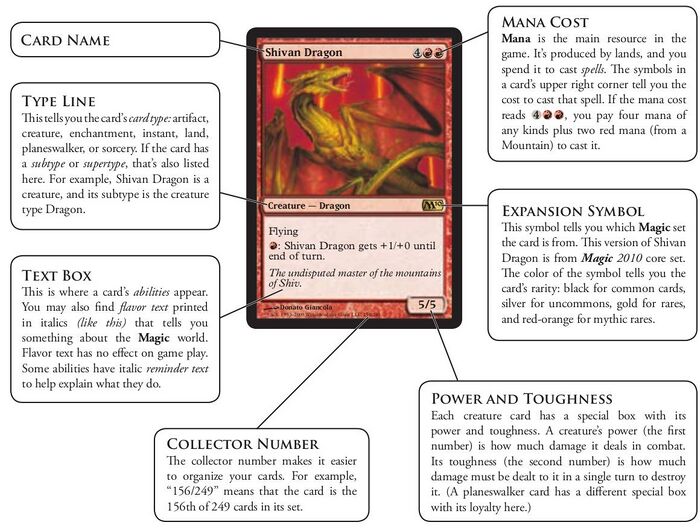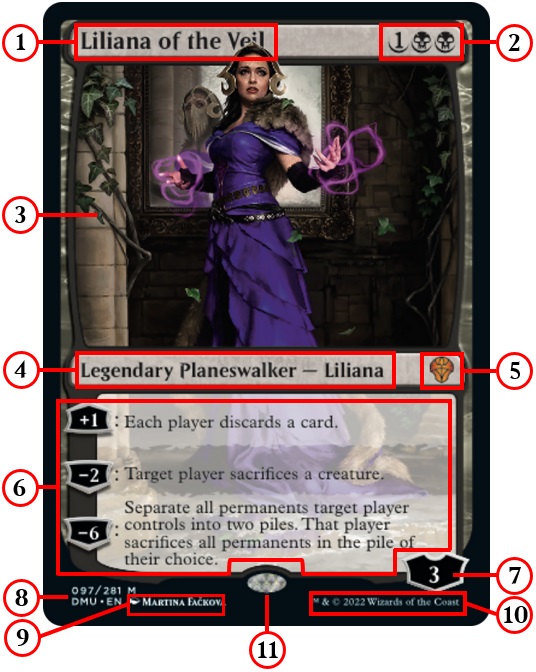Card
In Magic: The Gathering, the word card always refers to a Magic card with a Magic card front and a Magic card back, or to double-faced cards. Tournament-legal cards are 2.5 x 3.5 inches (6.35 x 8.89 cm) and weigh 0.064 ounces (1.814 grams).[1] Non-foil cards are approximately 0.012 inches (0.305 mm) thick. Magic cards, like regular playing cards, are made from two layers of cardboard joined together by an opaque black adhesive, so that they're opaque even seen in direct sunlight. Foil cards have an extra foil layer on the card that highlights certain parts of the artwork over others.
Rules
A card is only referred to as a "card" by game rules or effects when in a player's hand, library, or graveyard, or in exile. Tokens are never considered cards, even if cards are used to represent them. When a card has been cast and is on the stack waiting to resolve, the game refers to it as a "spell." When a card is on the battlefield, the game refers to it as a "permanent," or simply by its type or subtype.
Lua error in Module:CR at line 549: Unknown error, multiple lookups .
From the ()
Parts of a card
On a card, several elements can be distinguished.[2][3]
| Non-planeswalker cards (general) | Planeswalker cards |

|
 1: name; 2: mana cost; 3: illustration; 4: type line; 5: subtypes; 6: expansion/set symbol; 7: text box for rules text and/or flavor text; 8: illustrator; 9: loyalty; 10: other, sub-text box information (including copyright information and collector's number). 1: name; 2: mana cost; 3: illustration; 4: type line; 5: subtypes; 6: expansion/set symbol; 7: text box for rules text and/or flavor text; 8: illustrator; 9: loyalty; 10: other, sub-text box information (including copyright information and collector's number).
|
Marked cards
A marked card is a card in a deck that can be identified by some means other than looking at its face. Protective sleeves can also be considered marked in a similar manner. Marked cards are illegal in all tournament play because there may be the chance that the player is cheating by knowing all the marks and may predict his/her draws.
Some examples of features that make a card "marked" include excessive wear, patterned wear, pen markings, card curvature or card-back color saturation. Card curvature can matter when using foiled premium cards, as early foil cards would warp differently than normal cards. Card-back color saturation can matter when using cards from different sets, especially when combining older and newer cards. Older cards tend to have a more varied and lower saturation to the card back while newer cards have a more homogeneous and higher saturation to them.
Altered cards
Some players and collectors have their cards signed by artists, written on by celebrities, drawn on, or otherwise "embellished". In tournaments it is always the head judge's call as to whether a card is "disruptively" altered. Cards with just signature on them are almost universally acceptable; the fuzziness starts when the whole text box is covered or if the art is obscured too much. Even if the card name is readable, altered cards can be ruled illegal if they seem deceptive to your opponent from a distance.[4]
Counterfeits
If a non-foil Magic card is bent corner-to-corner (or top-to-bottom), it will not crease, and will return to its original state. This is one way in which people test for counterfeit cards.
Illegal counterfeit boxes of Magic as well as counterfeit single cards have been produced and distributed. Most counterfeits are easily distinguishable as fakes by a different color, gloss coating or texture.[5] Wizards of the Coast takes legal action, when appropiate.[6]
In 2002, white-bordered versions of regular black-borderered cards were sold as exclusives. It turned out it was possible to "erase" the border off of a card using transparent tape and a good eraser.[7]
References
- ↑ Kelly Digges (April 24, 2007). "Ask Wizards - April, 2007". magicthegathering.com. Wizards of the Coast.
- ↑ Ted Knutson (October 21, 2006). "Anatomy of a Magic Card". magicthegathering.com. Wizards of the Coast.
- ↑ Ken Nagle (June 15, 2009). "Convertible Design". magicthegathering.com. Wizards of the Coast.
- ↑ Aaron Forsythe (April 16, 2002). "Customizing Your Collection". magicthegathering.com. Wizards of the Coast.
- ↑ Mike Elliott (April 26, 2004). "Buyer Beware". magicthegathering.com. Wizards of the Coast.
- ↑ Template:NewRef
- ↑ Magic Arcana (November 29, 2002). "White borders?!". magicthegathering.com. Wizards of the Coast.